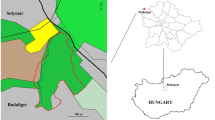Abstract
We derive point and interval estimates for an urban population of green tree frogs (Hyla cinerea) from capture–mark–recapture field data obtained during the years 2006–2009. We present an infinite-dimensional least-squares approach which compares a mathematical population model to the statistical population estimates obtained from the field data. The model is composed of nonlinear first-order hyperbolic equations describing the dynamics of the amphibian population where individuals are divided into juveniles (tadpoles) and adults (frogs). To solve the least-squares problem, an explicit finite difference approximation is developed. Convergence results for the computed parameters are presented. Parameter estimates for the vital rates of juveniles and adults are obtained, and standard deviations for these estimates are computed. Numerical results for the model sensitivity with respect to these parameters are given. Finally, the above-mentioned parameter estimates are used to illustrate the long-time behavior of the population under investigation.
Similar content being viewed by others
References
Ackleh, A. S. (1997a). Parameter estimation in a structured algal coagulation fragmentation model. Nonlinear Anal., 28, 837–854.
Ackleh, A. S. (1997b). Parameter estimation in the nonlinear size-structured population model. Adv. Syst. Sci. Appl. Special Issue, 1, 315–320.
Ackleh, A. S., Banks, H. T., Deng, K., & Hu, S. (2005). Parameter estimation in a coupled system of nonlinear size-structured populations. Math. Biosci. Eng., 2, 289–315.
Ackleh, A. S., & Deng, K. (2009). A nonautonomous juvenile–adult model: well-posedness and long-time behavior via a comparison principle. SIAM J. Appl. Math., 69, 1644–1661.
Ackleh, A. S., Carter, J., Cole, L., Nguyen, T., Monte, J., & Pettit, C. (2010a). Measuring and modeling the seasonal changes of an urban green treefrog (Hyla cinerea) population. Ecol. Model., 221, 281–289.
Ackleh, A. S., Deng, K., & Huang, Q. (2010b). Existence-uniqueness results and difference approximations for an amphibian juvenile-Adult Model. Contemp. Math.- Am. Math. Soc., 513, 1–23.
Ackleh, A. S., Deng, K., & Huang, Q. (2011). Stochastic juvenile–adult models with application to a green tree frog population. J. Biol. Dyn., 5, 64–83.
Adams, B. M., Banks, H. T., Banks, J. E., & Stark, J. D. (2005). Population dynamics models in plant-insect herbivore-pesticide interactions. Math. Biosci., 196, 39–64.
Banks, H. T., & Kunisch, K. (1989). Estimation techniques for distributed parameter systems. Boston: Birkhäuser.
Bielby, J., Cunningham, A. A., & Purvis, A. (2006). Taxonomic selectivity in amphibians: ignorance, geography, or biology? Anim. Conserv., 9, 135–143.
Blouin, M. S. (1992). Genetic correlations among morphometric traits and rates of growth and differentiation in the H. cinerea. Evolution, 3, 735–744.
Calsina, A., & Saldana, J. (1995). A model of physiologically structured population dynamics with a nonlinear individual growth rate. J. Math. Biol., 33, 335–364.
Davidian, M., & Giltinan, D. M. (1995). Nonlinear models for repeated measurement data. New York: Chapman and Hall/CRC.
Garton, J. S., & Brandon, R. A. (1975). Reproductive ecology of the green treefrog, Hyla cinerea, in Southern Illinois (Anura: Hylidae). Herpetology, 31, 150–161.
Gunzburger, M. S. (2006). Reproductive ecology of the green treefrog (Hyla cinerea) in Northwestern Florida. Am. Midl. Nat., 155, 321–328.
Kiesecker, J. M., Blaustein, A. R., & Belden, L. K. (2001). Complex causes of amphibian population declines. Nature, 410, 681–684.
Pham, L., Boudreaux, S., Karhbet, S., Price, B., Ackleh, A. S., Carter, J., & Pal, N. (2007). Population estimates of Hyla cinerea (Schneider) (green treefrog) in an urban environment. Southeast. Nat., 6, 203–216.
Pounds, J. A., Bustamante, M. R., Coloma, L. A., Consuegra, J. A., Fogden, M. P. L., et al. (2006). Widespread amphibian extinctions from epidemic disease driven by global warming. Nature, 439, 161–167.
Smith, K. T. (2005). Effects of nonindigenous tadpoles on native tadpoles in Florida: evidence of competition. Biol. Conserv., 123, 433–441.
Stuart, S. N., Chanson, J. S., Cox, N. A., Young, B. E., Rodrigues, A. S. L., et al. (2004). Status and trends of amphibian declines and extinctions worldwide. Science, 306, 1783–1786.
Wright, A. H., & Wright, A. A. (1949). Handbook of frogs and toads of the United States and Canada (pp. 303–307). New York: Comstock Publishing Company.
Yang, X., & Pal, N. (2010). Estimation of a population size through capture–mark–recapture method: a comparison of various point and interval estimators. J. Stat. Comput. Simul., 80, 335–354.
Yang, X., Pal, N., Ackleh, A. S., & Carter, J. A case study of green tree frog population size estimation by repeated capture–mark–recapture method with individual tagging. J. Stat. Comput. Simul. (2011, accepted for publication).
Young, B. E., Lips, K. R., Reaser, J. K., Ibanez, R., Salas, A. W., et al. (2001). Population declines and priorities for amphibian, conservation in Latin America. Conserv. Biol., 15, 1213–1223.
Author information
Authors and Affiliations
Corresponding author
Rights and permissions
About this article
Cite this article
Ackleh, A.S., Carter, J., Deng, K. et al. Fitting a Structured Juvenile–Adult Model for Green Tree Frogs to Population Estimates from Capture–Mark–Recapture Field Data. Bull Math Biol 74, 641–665 (2012). https://doi.org/10.1007/s11538-011-9682-0
Received:
Accepted:
Published:
Issue Date:
DOI: https://doi.org/10.1007/s11538-011-9682-0




